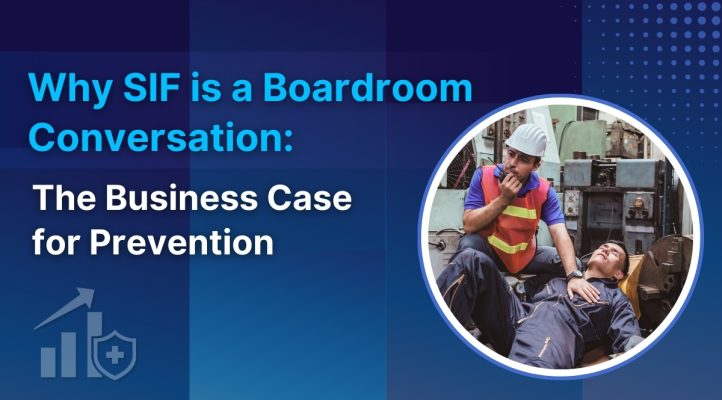Why SIF Prevention Is a Must for Business Survival

Why SIF Prevention Demands Executive Attention
Workplace safety is no longer just about compliance; it’s a core business priority that directly impacts financial performance, corporate reputation, and operational efficiency. When an organization is looking to go beyond the monitoring of incident rate and begin to move toward eliminating systemic incidents, where do they turn their efforts? Organizations focusing on Serious Injuries and Fatalities (SIF) potential incidents are looking beyond the incident rate. SIF incidents pose significant risks that require leadership engagement at the highest level.
Organizations that fail to prioritize SIF prevention risk costly disruptions, legal liabilities, and reputational damage. Therefore, executives must shift from reactive safety measures to a proactive risk management approach. Businesses must go beyond regulatory compliance and the basic incident rate by actively preventing SIF through strategic safety measures and integrating risk management into their core operations.
This blog explores why SIF prevention is a pressing issue for leadership, how it impacts corporate reputation, operational efficiency, and long-term financial stability, and why businesses must shift from reactive compliance to proactive risk management.

The Corporate Reputation Factor
A single SIF incident can have lasting repercussions on a company’s reputation. Public perception, brand trust, and investor confidence can deteriorate rapidly after a workplace tragedy. Social media and digital news platforms amplify the impact of these incidents, holding organizations accountable in real-time.
Executives must consider the broader implications of safety failures, including:
- Damage to employer brand and talent acquisition efforts
- Negative media coverage that affects customer trust
- Investor concerns over governance and risk management
Proactive SIF prevention demonstrates a company’s commitment to ethical leadership and workplace responsibility, reinforcing positive stakeholder relationships.
Operational Efficiency and Workforce Productivity
Beyond compliance, preventing SIF incidents directly influences operational performance. Workplace injuries and fatalities disrupt production, increase downtime, and lead to costly investigations. A strong safety culture reduces the likelihood of incidents, enabling businesses to operate more efficiently.
Key operational benefits of SIF prevention include:
- Lower incident-related downtime and disruptions
- Fewer workplace disruptions and improved team collaboration
- Improved safety culture that enhances morale and productivity
- Better throughput and overall effectiveness
When safety is prioritized at the leadership level, frontline employees feel empowered to report hazards, and organizations can implement more effective risk mitigation strategies.
Financial Stability and Risk Mitigation
From a financial standpoint, SIF incidents carry substantial direct and indirect costs. Medical expenses, legal liabilities, regulatory fines, and worker’s compensation claims quickly impact a company’s bottom line. Additionally, businesses may face increased insurance premiums and diminished shareholder value if safety concerns are not adequately addressed.
Investing in SIF prevention reduces these financial risks while ensuring compliance with evolving regulations. Forward-thinking companies recognize that proactive safety initiatives yield long-term cost savings by preventing incidents before they occur.
SIF Prevention: A Top Boardroom Priority
Executive leadership must integrate SIF prevention into strategic decision-making to drive meaningful change. This involves:
- Leadership Commitment: Establishing clear accountability for safety performance at the highest levels of the organization.
- Data-Driven Insights: Leveraging technology and analytics to identify and mitigate high-risk scenarios.
- Employee Involvement: Cultivating a proactive safety culture that encourages participation from all levels of the organization.
- Visibility to Data: Keeping SIF potential as a leading metric moves to a proactive rather than reactive safety culture.
How Rhythm Innovations Can Help
At Rhythm Innovations, we understand the complexities of SIF prevention and provide cutting-edge solutions to help businesses manage safety risks. Our platform enables organizations to:
- Enhance Risk Visibility: Utilize real-time data analytics to identify high-risk areas and prevent incidents before they occur.
- Streamline Compliance Management: Automate safety tracking and reporting to ensure regulatory compliance easily.
- Improve Safety Culture: Facilitate employee communication and collaboration to drive a proactive safety-first mindset.
- Enable Predictive Safety Measures: Leverage AI-driven insights to foresee potential hazards and implement preventive measures efficiently.
By integrating Rhythm Innovations’ technology into their safety strategy, organizations can take a proactive approach to SIF prevention, protecting their workforce while strengthening their operational and financial stability.
Conclusion: A Business Imperative for Long-Term Success
SIF prevention has evolved from a compliance requirement to a fundamental pillar of business strategy. Organizations prioritizing safety at the boardroom level benefit from enhanced reputation, improved operational efficiency, and greater financial resilience. By taking a proactive approach to safety, companies foster a more secure work environment and drive long-term business growth and resilience.
Contact us today for more information on how Rhythm Innovations can support your safety initiatives!


